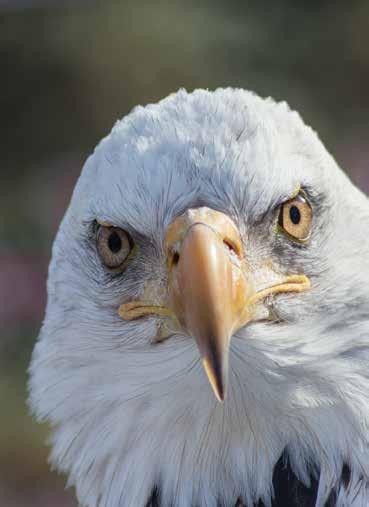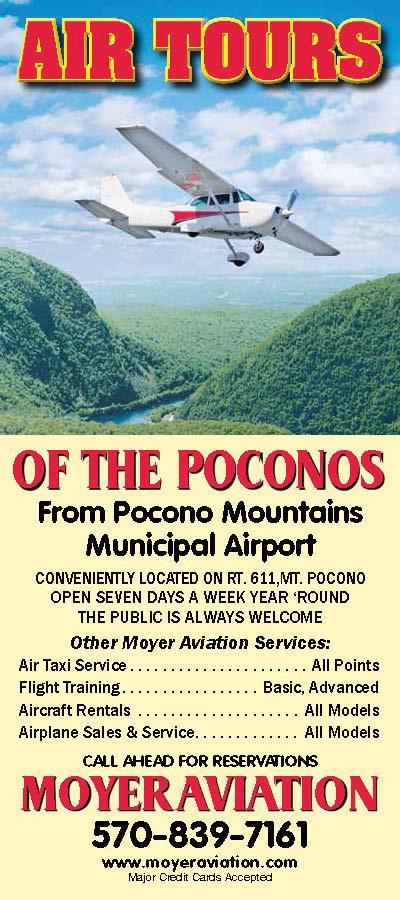
8 minute read
A Triumphant Return
Photo courtesy of Unsplash
By Brian Hardiman
Iwas beginning to have my doubts as I stood there in the cold and snow. We had been waiting and watching in this one spot for over twenty minutes but still nothing. Furiously wiggling my toes and fingers did little to thwart the numbness setting in. A
quick scan of the now restless group showed others stomping their feet and huddling
together in a losing effort to stay warm. At least I’m not the only one suffering, I thought
to myself.
And then it happened…I don’t remember who was the first to see it and call out, but
suddenly all eyes were on the spectacular sight that appeared almost magically before us.
Frozen extremities were quickly forgotten and the conversation about last weekend’s party
abruptly ended. An adult bald eagle, with wings pumping slowly, passed by the hushed
group of onlookers at eye level, held its course down the river, and disappeared, like a
vision, around the bend. It was simply awesome.
This eagle sighting occurred in the Poconos on a field trip in February, 1984, when I was a
student in Dr. Larry Rymon’s Ornithology class at East Stroudsburg University, and it was
the very first bald eagle that I (and most of the class) had ever seen in the wild. It is one
that will be forever etched in my mind.
Standing on the banks of a remote section of the Delaware River that day was in itself
exhilarating and memorable -- snow was falling and the flakes accentuated the green
of the towering hemlocks around us. There were no traffic noises to be heard, only
the soothing sounds of the rushing water below us. Yes it was cold, but the thrill and
anticipation of possibly seeing a bald eagle trumped any hardship. Besides, Dr. Rymon
said this was the best place to see a bald eagle, and everyone knew that Doc (as he was
affectionately called by his students) had the bird gods on his side. After we actually did
see that eagle (just as Doc had predicted), his legendary status only grew.
Eagle sightings back in 1984 were an uncommon event. At
that time there was only a very small wintering population in
the Poconos and no nesting eagles at all. Today, because of the
increase of the local wintering and nesting populations, you
don’t need a legend like Doc Rymon to find bald eagles. You
just need to know when and where to go.
The best time to see bald eagles in the Poconos is during
the non-breeding winter months when the small resident
population is supplemented by wintering birds that are forced
south to our area by the frozen waters up north. The eagle
numbers are highest at this time and visibility is best with the
lack of foliage. Wintering eagles start moving into our area
in December, with peak numbers usually seen in January and
February. These numbers drop off in March as the eagles
disperse and move back north.
Among the best places to see bald eagles is along the Delaware
River. Even in the coldest winters, stretches of the Delaware
will have open water that provides fishing and other foraging
opportunities for these birds. Locations in the Delaware Water
Gap National Recreation Area (DWGNRA) offer excellent
chances to see bald eagles. This 70,000 acre National Park Service site has outstanding eagle habitat that meets the needs
of wintering and nesting birds. The river provides food, and the
stands of large deciduous and coniferous trees provide perches
for foraging and roosting and sites for nesting.
Some of the best viewing areas in DWGNRA are the river
access sites at Smithfield Beach, Bushkill, Dingmans Ferry, and
Milford. Eagles can often be seen perched at river’s edge or
soaring overhead on their large, flat plank-like wings. A really
lucky observer may even see an eagle snagging a fish from the
river or picking a duck off the water’s surface or from midair.
Eagles are opportunistic and will take other prey as well. I once

SHOP NEW. SHOP VINTAGE. SHOP LOCAL.

saw an eagle carrying a gray squirrel in its talons, and another
time while leading an eagle field trip, my group and I watched
an eagle grab a muskrat from the river, fly off with it low across
the water with the muskrat’s tail dragging, and land on a rock
where it ate the animal. Bald eagles are also scavengers and my
groups, on more than one occasion, have seen multiple eagles
feeding on a winter-killed deer.
To many the bald eagle symbolizes courage, freedom, and
wilderness. It was selected by Congress in 1782 as the national
symbol of the United States, despite the objections of Ben
Franklin who felt the bald eagle possessed poor moral character
(reflected in its behavior of pirating food from other species) and
was a poor choice next to Franklin’s own wild turkey. In my
humble opinion, I believe the appropriate choice was made.
Eagles are birds of strength, beauty, and size, and different
species have been chosen as the national symbols of countries
around the world. The bald eagle is the only eagle species found
exclusively on the North American continent, and it would be
difficult to imagine any other bird, wild turkey or otherwise, as
our national symbol.
It’s not just a day of shopping here in the Pocono Mountains—it’s an experience. Wander our historic streets. Explore our art galleries. Find unique local goods. And stop for a bite at one of our top-rated neighborhood restaurants along the way. Discover all of our shopping and sights now at PoconoMountains.com.

Majestic and regal, an adult bald eagle is unmistakable with its
striking white head and tail contrasting against the dark brown
body. This adult plumage is attained at about five years of
age. Immature birds, on the other hand, are basically brown
throughout with varying degrees of white mottling depending
on age. Bald eagles are impressive birds in terms of size—they
can stand thirty inches from head to tail with wingspans reaching
seven feet. The weight of these birds can range from about eight
to fourteen pounds, with females larger than males (the sexes,
otherwise, are similar in appearance).
Once on the brink of extinction throughout most of its range,
the bald eagle has made a remarkable comeback. Habitat loss,
human persecution, and especially DDT contamination all
played a role in eagle populations plummeting. At the time
of European settlement, there was an estimated 100,000 bald
eagles in North America. By 1963, less than 500 nesting pairs
were known to occur in the contiguous United States. The bald eagle would soon be designated as an endangered species at the
federal and state levels.
A number of factors were responsible for the recovery of
our national symbol. The banning of DDT was crucial in
this turnaround, as well as protection of the species and its
habitat provided under state and federal Endangered Species
Acts. Increased education efforts to reduce human persecution
and the improvement of water quality were also boons to the
eagle population. Another major contributor to the bald eagle
recovery were reintroduction programs implemented by various states including Pennsylvania. These efforts gave the population
a jumpstart in areas where historically eagles once nested.
Combined, these recovery efforts have produced dramatic results.
As recently as 1980, there were only three known eagle nests in
the state of Pennsylvania. Today the state’s nesting population
is well over 100 pairs, with a number of these birds nesting
right here in the Poconos. Other states have experienced similar

PoconoFourWheelDrive.com

Photos courtesy of Unsplash
increases. As a result, in 2007 the bald eagle was removed from
the federal list of endangered and threatened species. However,
it is still afforded federal protection by the Bald Eagle Protection
Act and the Migratory Bird Treaty Act, as well as being protected
by endangered species laws at the state level.
Once only a rare winter sight in the Poconos, now it is not
surprising to see a bald eagle any day of the year in our area.
Their presence is a testament to the outstanding quality of our
natural environment here in the Poconos. Looking back on that
day along the Delaware when I saw my first bald eagle with Doc
and my classmates, I never imagined that 25 years later the bald
eagle would make the triumphant return that it has. In that time
I have seen literally hundreds of bald eagles, and every one is
special, but I’ll never forget that first one.
Editor’s Note: This article first appeared in our February 2012 issue. It is reprinted now as a reminder of the progress our country has made in protecting our national symbol. Ken’s Auto Service Center Quality Repair With a Price That’s Fair Rte. 447 & Brushy Mt. Rd., East Stroudsburg, PA 18301 570-424-2258 www.kensautoservicecenter.net


Oil Change State Inspections Tune Ups Maintenance Brakes Tires
Air Tours of the Poconos

Charter Flights Flight Training Other Air Services Gift Certificates Available
Pocono Mountains Airport - 188 Airport Drive, Tobyhanna, PA 1-800-321-5890 MoyerAviation.com



